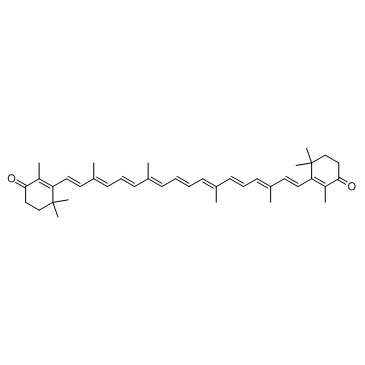Canthaxanthin (E 161g) |
| Catalog No.GC30495 |
Canthaxanthin (E 161g) is a red-orange carotenoid with various biological activities, such as antioxidant, antitumor properties.
Products are for research use only. Not for human use. We do not sell to patients.

Cas No.: 514-78-3
Sample solution is provided at 25 µL, 10mM.
Canthaxanthin is a red-orange carotenoid with various biological activities, such as antioxidant, antitumor properties.
Canthaxanthin enrichment of LDL has the potential to protect cholesterol from oxidation. In addition to its free radical scavenging and antioxidant properties (e.g., the induction of catalase and superoxide dismutase), canthaxanthin shows immunomodulatory activity (e.g. enhancing the proliferation and function of immune competent cells) and plays important role in gap junction communication (e.g. induction of the transmembrane protein connexin)[1]. At concentrations of 0.1 to 1 x 1000 μM, canthaxanthin significantly reduces the overall number of tumor cells. The greatest inhibition is observed at a canthaxanthin concentration of 1000 after 72 h and 96 h of incubation[2].
Canthaxanthin alters the protective ability of tissues against oxidative stress. Canthaxanthin treatment for 15 d at the dose of 14 μg/kg body weight results in hepatic incorporation of the carotenoid, which is maximum in liver and reaches 0.52 ± 0.05 nmol/g liver. Glutathione peroxidase activity is 35% lower and catalase (59%) and manganese superoxide dismutase (28%) activities are higher in canthaxanthin-treated mice than in controls[3]. Canthaxanthin inhibit the growth of mammary tumors in mice and the anti-tumor activity is also influenced by the supplemental dose[4]. Diet supplementation with canthaxanthin for 3 weeks prior to the carcinogen results in a 65% reduction in the number of mammary cancers by a mechanism not involving pro-vitamin A activity[5].
[1]. Esatbeyoglu T, et al. Canthaxanthin: From molecule to function. Mol Nutr Food Res. 2017 Jun;61(6). [2]. Huang DS, et al. Inhibitory effects of canthaxanthin on in vitro growth of murine tumor cells. Cancer Lett. 1992 Aug 31;65(3):209-13. [3]. Palozza P, et al. Canthaxanthin supplementation alters antioxidant enzymes and iron concentration in liver of Balb/c mice. J Nutr. 2000 May;130(5):1303-8. [4]. Chew BP, et al. A comparison of the anticancer activities of dietary beta-carotene, canthaxanthin and astaxanthin in mice in vivo. Anticancer Res. 1999 May-Jun;19(3A):1849-53. [5]. Grubbs CJ, et al. Effect of canthaxanthin on chemically induced mammary carcinogenesis. Oncology. 1991;48(3):239-45.
Average Rating: 5 (Based on Reviews and 33 reference(s) in Google Scholar.)
GLPBIO products are for RESEARCH USE ONLY. Please make sure your review or question is research based.
Required fields are marked with *




















